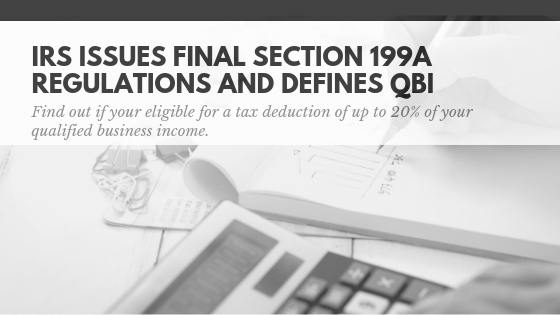If you are currently operating a pass-through business such as a proprietorship, partnership, or S corporation, you might want to have a look at this.
Thanks to the finalized regulations of Section 199A, you can now be eligible to have a tax deduction of up to 20 percent of your qualified business income (QBI).
The QBI deduction is available in tax years beginning after Dec. 31, 2017. This means that eligible taxpayers will be able to claim it for the first time on their 2018 Form 1040.
Also, take note that the QBI deduction is generally available to eligible taxpayers with 2018 taxable income at or below $315,000 for joint returns and $157,500 for other filers.
If you think you qualify for this deduction, you can compute your withholding by applying the 20 percent to the lesser of your:
- defined qualified business income (QBI), or
- taxable income less defined capital gains
For instance, if you have a defined QBI of $100,000 and a taxable income of $150,000 with no capital gains, you get a deduction of $20,000 (20 percent of the QBI).
Proprietorships, partnerships, S corporations, and certain trusts, estates, and rental properties are eligible for this significant deduction; however, this is not available for a C corporation.
QBI Defined
The tax code defines QBI as the net amount of qualified items of income, gain, deduction, and loss from any skilled trade or business. This includes income from partnerships, S corporations, sole proprietorships, and certain trusts.
In general, QBI includes but is not limited to the deductible part of self-employment tax, self-employed health insurance, and deductions for contributions to qualified retirement plans (e.g., SEP, SIMPLE, and qualified plan deductions).
Sole Proprietorship
The QBI for a sole proprietor begins with your net business profit as shown on your Schedule C. You can then adjust that profit through this simple computation:
- Subtract the deduction for self-employed health insurance.
- Subtract the deduction for one-half of the self-employment tax.
- Subtract qualified retirement plan deductions.
- Subtract net Section 1231 losses (ignore gains).
Rental Property
For rental property owners (individual or through a single-member LLC where corporate taxation is not elected), you report your rental activity on Schedule E of your Form 1040.
If you can claim the property as a trade or business, your QBI begins with the net income from your Schedule E.
For the 2018 tax returns, ignore previously suspended passive losses. For the subsequent years, you should only consider suspended losses that you have incurred after December 31, 2017.
If the rental creates Section 1231 net losses, subtract those losses from QBI.
Partnerships
Interestingly, a partner may obtain income from the partnership in two ways:
as a payout of profits and/or
as a Section 707 payment (generally referred to as a guaranteed payment)
The profits qualify as QBI, and the partnership profits are adjusted for the same items as the sole proprietorship.
Remember that Section 707 payments reduce the net income of the partnership, and they do not count as QBI.
S Corporation Shareholder
A shareholder in an S corporation can calculate QBI the same way as for the sole proprietor. For instance, the S corporation treats health insurance as wages to the shareholder. This reduces the profits of the S corporation, and that reduces the shareholder’s QBI.
Furthermore, wages paid to the shareholder-employee reduce the net income of the S corporation and do not count as QBI.
S corporation capital gains and losses, dividends, and interest earned at the S corporation level are also not QBI. The shareholder K-1 will likely show the adjustments for these items.
Trusts and Estates
Although the same rules mentioned above apply to trusts and estates, knowing where to use the rules (whether to the trust, to the estate, or to the beneficiary) makes this a bit tricky.
Dealing with Losses
When it comes to losses, you don’t have to consider suspended tax losses under Sections 465, 469, 704(d), and 1366(d) for 2018 tax returns if the losses happened before January 1, 2018.
Moreover, for 2019, you need to examine the losses using a first-in, first-out approach and reduce your QBI for post-2017 losses that are released during 2019. You must follow the first-in, first-out procedure from 2019 to 2025.
Conclusion
Overall, the final regulations from the IRS clearly define what makes up your QBI. Keep in mind that if your 2018 taxable income is equal to or less than $315,000 (joint returns) or $157,000 (other filings), your Section 199A 20 percent deduction is equal to the lesser of your
- defined QBI or
- taxable income less net capital gains
To recall if your qualifying trade or business income is from a proprietorship, your 2018 QBI is the net profit from Schedule C which is calculated by
subtracting the deduction for self-employed health insurance (line 29 of Schedule 1 to your Form 1040);
- subtracting the deductible portion of your self-employment tax (line 27 of Schedule 1 to your Form 1040);
- subtracting your self-employed SEP, SIMPLE, and qualified retirement plan contributions (line 28 of Schedule 1 to your Form 1040); and
- subtracting net Section 1231 losses (ignore gains)
For partnerships or S corporation, the concept is quite the same. What you see when you consider the adjustments is that your QBI is business income less both business deductions and deductions triggered by the business, such as the self-employed health insurance deduction.
These calculations can be pretty intimidating, especially if you don’t have the time to go through all these on your own. Why not take the stress-free approach and talk to a tax expert instead. Remember, the fewer taxes you pay, the more profit you get for you and your business.


